#also yes i'm aware that knockout is spelled knock out
Text
Transformers Prime characters and their favorite Winx + their similarities based on how I see it
Btw, as someone who watched Winx Club more than TFP I'm aware that some of these may be inaccurate, and therefore anyone is allowed to leave any corrections or just opinions. Whether you're from the TFP fandom or the Winx Club fandom, I'd appreciate it.
Bloom being Optimus' favorite
I think because how both have become leaders of their groups with the similar backstories too. Optimus Prime was used to be just Orion Pax as an archivist before got turned to a Prime, and Bloom was also a human at first before discovering she's a fairy and the strongest one who has the dragon flame power. For their personalities, yes, they're different. I do say both are very considerate about their actions and so.
Not gonna lie I do kinda think that Bloom could be Predaking's favorite too just because Predaking also have fire powers or just fire breath or just... dragons. You know what I mean. But I do also like to imagine Bloom would likely be a Predacon and turn to her own dragon-beast form. Just imagine if she could do that in the original show itself.
Stella being Knockout's favorite
Honestly both of them are iconic in their own show. They really prioritize their appearances well and get pissed off if someone just ruined their moment. At least for Knock Out in my opinion but Stella could also. Other than their personalities, I don't have much to say. But I do like how they like to use their staff/scepter. Also I don't know why but I imagine or just think Stella and Brandon having similar dynamic like Knockout and Breakdown.
Aisha/Layla being Arcee's favorite
They could relate so much to each other!! LISTEN! Both of them suffered so much with trauma and losing the people they loved and cared for, and they're willing to take revenge! They deserve a break and just hug each other, seriously. Besides that, I think they both have the same physical strength and are able enough to defend themselves from anything.
Tecna being Shockwave's favorite
No surprise at all. I could write so much about this logical duos. Literally the moment Tecna says anything about logic or saying something rationally or scientifically for the first time, Shockwave would be like:
"That's my favorite right there! It is only logical that she's so similar me!"
He would probably be really fascinated by her powers and her interests. Although I couldn't really tell what Tecna would think about him in canon. But I think both could actually get along and work together on some kind of project or something since both are also ambitious. They'll be talking so much stuff about science, technologies and Tecna could explain technomagic, and so on. The moment Tecna sacrificed herself and went gone probably caused Shockwave to have an emotional breakdown somehow. I also feel like Shockwave would dislike Timmy a little. Don't know why. Probably because I write this one AU where Shockwave and Soundwave are literally her parents/creators.
Musa being Soundwave's favorite
Now this is a tricky one. Because I feel like Soundwave's favorite would be Tecna and Musa in which he couldn't choose one between them. Also I think Soundwave and Tecna has this similar ability where they both can connect to any computer devices but it's probably not the same either.
If I am not mistaken, didn't Musa has that one spell that's name 'Soundwaves' or something similar to it? I mean, if we're talking about their abilities, I would say... not really or just not much the same?? Because when I think about Soundwave and his own abilities, I would say it's like the combination of Tecna's and Musa's powers.
Thus, the reason why I think Musa would be Soundwave's favorite is I think he would feel touched and/or at least feel sympathy or empathy regarding her past. I also feel like Soundwave would observe her most throughout including her relationship with Riven and others.
Flora being Bumblebee's favorite
This one is the hardest. For me, Bumblebee is the closest one to her. Not because I think they're both the nicest or anything. I always feel like they both have this potential that they keep to themselves or are afraid to use. Although it is towards Flora more.
Other than that... they're trying their best.
#transformers#transformers prime#tfp#optimus prime#knockout#arcee#shockwave#soundwave#bumblebee#winx club#winx bloom#winx stella#winx aisha#winx tecna#winx musa#winx flora
15 notes
·
View notes
Text
Doctor’s Notes: Sparks
Disclaimer: My work is intended for the Transformers: Prime continuity, but will draw reference from other Transformers series’ to incorporate more worldbuilding.
Spark and Spark Chamber Function
Sparks are source of Cybertronian life, and every living thing from Planet Cybertron has one, from Prime himself all the way down to the tiniest scraplet. If I had to choose only one human organ to compare it to, it’s closest in nature to the human heart; its primary function is to keep the flow of energy rolling through the bot it powers at a steady, consistent rate.
However, Cybertronian physiology rarely lines up 1:1 with its human counterpart. A spark fills a number of other functions, as follows:
Energy conversion: The spark takes the broken down energon from the fuel intake (digestive) system, refining it further and sending it through the spark chamber walls to be infused with nanites, essentially converting fuel-grade energon into blood-grade.
Thought and movement: This function is partially split between the spark and the Cybertronian processor; while the processor does the actual thinking and long-term memory retention, it’s the spark that dictates emotions, short-term memories, and functions of the body. The spark sends energy pulses to the processor, and those pulses are converted into usable signals for the frame to react to.
Soul: Far more clearly (and physically) defined in a Cybertronian body than a human’s, the spark, as the source of Cybertronian emotion, is often referred to as their soul. If you were to power up an empty frame without a spark, you would have a programmable drone rather than a person; the difference a spark makes is literally what gives them life.
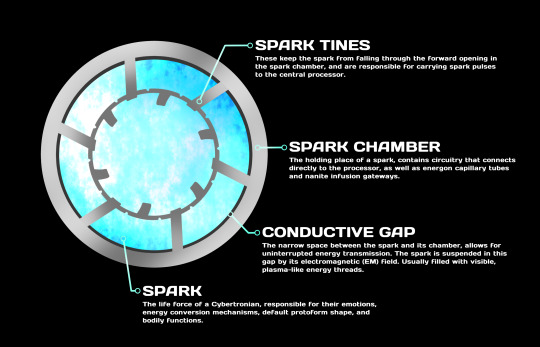
[Image ID: An illustration of the Cybertronian spark chamber, which shows a glassy blue sphere contained in a metal frame. Each piece is labeled accordingly: the circular chamber reads “Spark chamber: the holding place of a spark, contains circuitry that connects directly to the processor, as well as energon capillary tubes and nanite infusion gateways.” The spikes holding the sphere in place read “Spark tines: these keep the spark from falling through the forward opening in the spark chamber, and are responsible for carrying spark pulses to the central processor.” The narrow space between the edge of the spark chamber and the sphere reads “Conductive gap: the narrow space between the spark and its chamber, allows for uninterrupted energy transmission. The spark is suspended in this gap by its electromagnetic (EM) field. Usually filled with visible, plasma-like energy threads.” The sphere reads “Spark: the life force of a Cybertronian, responsible for their emotions, energy conversion mechanisms, default protoform shape, and bodily functions.” End ID]
Sentio Metallico and Spark Formation
The spark itself forms in a place called a hotspot. Hotspots are exceptionally rare, especially beyond Cybertron’s grounds. A hotspot forms when a concentrated burst from the Allspark—the wellspring of Cybertronian life—comes into contact with ground rich in a category of metal known as sentio metallico. Metals included in this category are as follows:
Cyberium, a common component of a bot’s outer plating
Cybernite, the main component of spark chamber metal, and the most commonly found sentio metallico variety to surround a spark
Cybertitanium, an incredibly durable and lightweight metal used in the wings of flying bots and the plating of smaller bots
Cybertonium, a green substance used in the creation of the processor’s memory chips, which needs to be carefully repaired as a bot ages
Durabyllium, an incredibly hard yet brittle metal commonly used to make and replace Cybertronian denta, but has found other use in drills and medical equipment
Tritanium, a metal that turns gold when tempered and functions as the main component of a bot’s skeletal frame
Trithyllium, a strong, dark grey metal that makes up the bulk of a bot’s body. It’s rare to come across someone who’s composed of pure trithyllium, instead most protoforms being made of a dilute alloy of it and steel
Ununtrium, an incredibly rare metal that’s impossible to break without being heated to its softening point, and used to reinforce the skeletal framework of bots fortunate enough to be made with it in ready supply
It is unknown why these metals specifically are found in hotspots. One prevailing theory is that the Allspark only generates sparks in the presence of materials it deems essential to life.
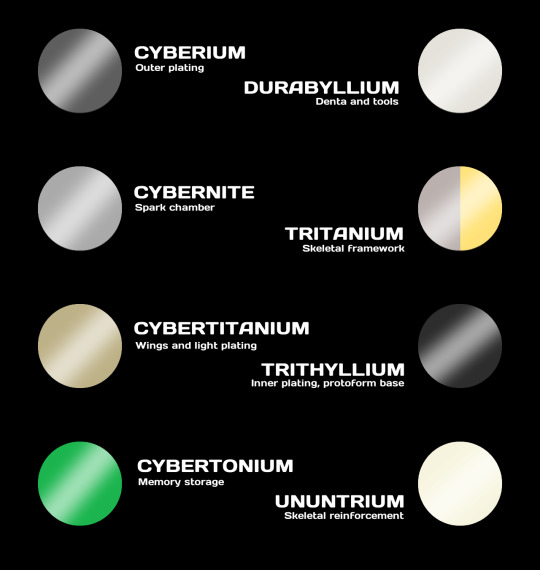
[Image ID: a table of the 8 types of sentio metallico, each labeled accordingly. The first is dark gray, labeled “Cyberium, outer plating,” the second is pale gray, labeled “Cybernite, spark chamber,” the third is dull gold, labeled “Cybertitanium, wings and light plating,” the fourth is vibrant green, labeled “Cybertonium, memory storage,” the fifth is light gray, nearly white, labeled “Durabyllium, denta and tools,” the sixth is split between dull reddish-gray and bright gold, labeled “Tritanium, skeletal framework,” the seventh is dark gray, nearly black, labeled “Trithyllium, inner plating, protoform base,” and the eighth is pale gold, nearly white, labeled “Ununtrium, skeletal reinforcement.” End ID]
The spark itself is pure light, and as such, has to be contained in a physical object to keep from scattering. When a hotspot produces a spark, the sparklight is sealed inside a bubble, and that bubble fills in with silicon material that the spark rearranges into a photonic crystal, which it then inhabits for the full extent of its lifetime.
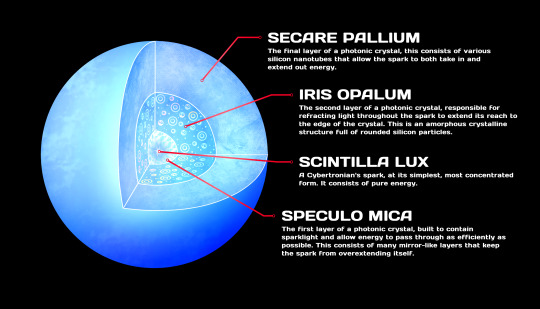
[Image ID: A detailed, labeled map of a cross-section of a photonic crystal. The central light is labeled “Scintilla lux: a Cybertronian’s spark, at its simplest, most concentrated form. It consists of pure energy.” The innermost layer is mirrorlike, labeled “Speculo mica: the first layer of a photonic crystal, built to contain sparklight and allow energy to pass through as efficiently as possible. This consists of many mirror-like layers that keep the spark from overextending itself.” The middle layer is full of bubble-like markings, labeled “Iris opalum: the second layer of a photonic crystal, responsible for refracting light throughout the spark to extend its reach to the edge of the crystal. This is an amorphous crystalline structure full of rounded silicon particles.” The outermost layer is cloudy and full of threads, labeled “Secare pallium: the final layer of a photonic crystal, this consists of various silicon nanotubes that allow the spark to both take in and extend out energy.” End ID]
Spark Color
The color of a Cybertronian spark varies wildly from Cybertronian to Cybertronian, each one having a different shade. However, despite this variance, spark color is usually only indicative of age, rather than spark type itself.
Normal sparks follow the same color patterns as main-sequence stellar classification; new sparks are bright blue, while old sparks are deep red. It takes, on average, a million Earth years for a spark to change its color, and after they turn red, they remain that way for the rest of their lives.
Green sparks are an anomaly referred to as “Point One Percenters,” due to the mistaken assumption that they make up 0.01% of all sparks found (the actual percentage is far steeper; a green spark is found once in maybe every ten hot spots to occur). These sparks, upon discovery, are incredibly dangerous and must be handled with care; the first flash they give out is known to cause rapid and irreversible spark failure in other normal sparks in proximity.
Point One Percenters have an INCREDIBLE output of power. Known Point One Percenters include Megatron, Ultra Magnus, Grimlock, and Shockwave.
These sparks are born green and stay green, though under a doctor’s trained optic, one can notice subtle changes in the shade the spark takes.

[Image ID: A labeled chart detailing spark colors. The blue spark is labeled “> 1 million, O class minor.” The light blue spark is labeled “2 million, O class major.” The pale blue spark is labeled “3 million, B class.” The white spark is labeled “4 million, A class.” The pale yellow spark is labeled “5 million, F class.” The yellow spark is labeled “6 million, G class.” The orange spark is labeled “7 million, K class.” The red spark is labeled “8 million +, M class. There are also three green sparks: the grass green spark is labeled “< 3 million, P class,” the emerald green spark is labeled “3 - 6 million, S class,” and the seafoam green spark is labeled “6 million +, N class.” End ID]
Spark Type
Spark type is decided by a number of factors that can be broken down into three categories: base type, spin, and input/output.
A spark’s base type refers to the structure of its photonic crystal.
Ferrous sparks are formed in hotspots that are dense in metals besides sentio metallico. They have broad etchings in anticipation of mineral-heavy energon, to allow it to pass through without obstruction. The most common metallic contaminant of hotspots is iron, from which ferrous sparks get their name.
Isomeric sparks are the most common, “default” sparktype. They have a fine network of etchings that give it a sandy appearance; these etchings can be viewed with the naked optic, but have to be examined closely to see.
Vitreous sparks are the rarest, and make up bots with a high immune response—and thus, a low tolerance to poison, venom, acid, and allergens. These are most common where there’s heavy electric activity in an area. Their etchings are microscopic, giving them a cloudy, glassy appearance, thus their name.

[Image ID: Three sparks, their brightness lowered for clarity. The first one has visible lines in it, and is labeled “Ferrous: coarse grain, large etchings.” The second one has sandy specks in it, and is labeled “Isomeric: sandy grain, small etchings.” The third one has smooth color fade, and is labeled “Vitreous: cloudy grain, microscopic etchings.” End ID]
A spark’s spin refers to the direction in which energy flows through it.
Positive sparks are the most common, and the energy flows counterclockwise from the top down, seen as moving from the left side of the spark to the right from the spark chamber opening. These are also called prograde sparks.
Negative sparks are less common than positive; in isomeric sparks, it’s a 60/40 split, but in the other two varieties, they’re much more rare. In a negative spark, the energy flows in a clockwise motion from the top down, moving from right to left from the spark chamber opening. These are also called retrograde sparks.
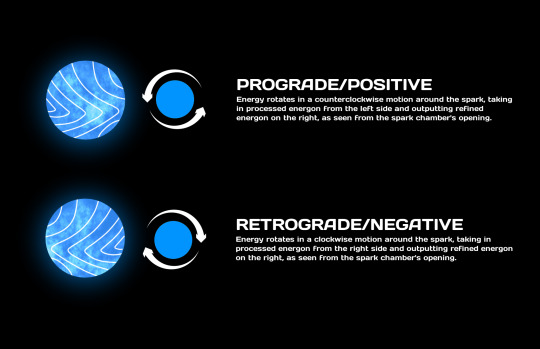
[Image ID: A chart detailing the flow of energy through a spark. The first spark has waves going from the left side to the right, with counterclockwise arrows circling a smaller blue circle beside it. It’s labeled “Prograde/Positive: Energy rotates in a counterclockwise motion around the spark, taking in processed energon from the left side and outputting refined energon on the right, as seen from the spark chamber’s opening.” The second spark has waves going from the right side to the left, with clockwise arrows circling a smaller blue circle beside it. It’s labeled “Retrograde/Negative: Energy rotates in a clockwise motion around the spark, taking in processed energon from the right side and outputting refined energon on the left, as seen from the spark chamber’s opening.” End ID]
The final factor in spark type is their I/O, or input/output settings. There are five varieties: output, input, high input, hybrid, and high output, though only the first four are found in normal bots.
Output sparks extend as much energy outward as they can into their frames. These belong to bulkier bots, like the majority of the Wrecker team, and bots with boxier frames. They’re stronger than most bots, but they have a predisposition towards spark failure.
Input sparks are the functional opposite of output sparks; they store energy rather than extend it, leading to bots with leaner frames. These tend towards racecars and other fast vehicle modes.
High input sparks store as much energy as possible. These sparks are relatively rare, and most commonly lead to what we call a “femme” frame. They need surgery before their first upgrade in order to properly handle the plating weight; those that don’t get surgery are stuck in tiny, human-sized forms called minibots/minicons.
Hybrid sparks are, from a combat perspective, the “ideal” spark, having traits from both output and input sparks; they give off enough energy to support sturdier frames, but they still get a distinct speed advantage over other bots.
Despite this, it’s important to note that hybrids are an anomaly in spark formation, caused by a tectonic shift mid-photonic crystal formation. As such, their protoforms have some irregularities; Starscream, who’s skews towards high input, has a very fragile frame, despite possessing the back strength to support wings. Knockout, an even 50/50 split, has delicate digits that don’t handle weight well. Nautica (MTMTE), who has higher output to input, has a very strong upper body, but a weaker lower body that requires bracers to support her weight.
Finally, high output sparks are the rarest; it’s hard to identify a high output before putting it in a protoform, and if it doesn’t form the right system immediately, it offlines from expending more energy than it can handle. However, if it does form those systems, or it’s accommodated for before being placed in a protoform, then high output sparks lead to titans like Metroplex and Omega Supreme.
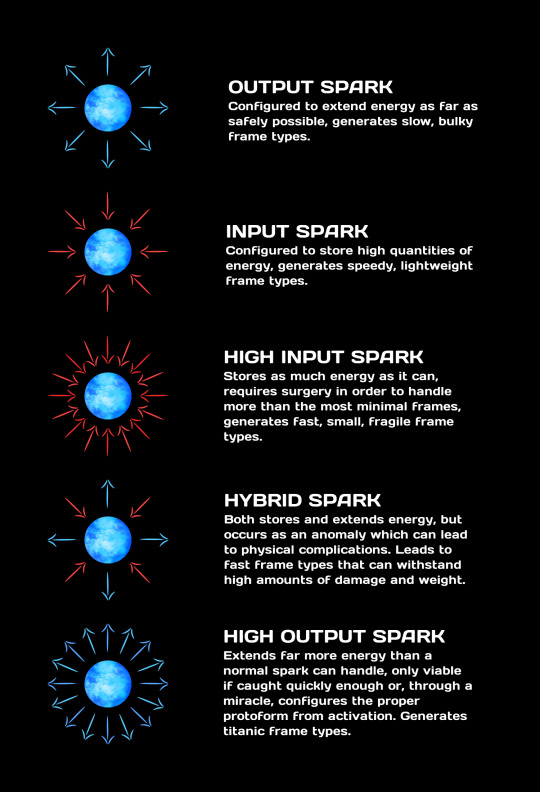
[Image ID: A chart detailing the different spark input/output variations. The first spark is surrounded by blue arrows pointing outward, and is labeled “Output spark: configured to extend energy as far as safely possible, generates slow, bulky frame types.” The second spark is surrounded by red arrows pointing inward, and is labeled “Input spark: configured to store high quantities of energy, generates speedy, lightweight frame types.” The third spark is surrounded by many red arrows pointing inward, and is labeled “High input spark: Stores as much energy as it can, requires surgery in order to handle more than the most minimal frames, generates fast, small, fragile frame types.” The fourth spark has four red arrows pointing inward and four blue arrows pointing outward around it, and is labeled “Hybrid spark: both stores and extends energy, but occurs as an anomaly which can lead to physical complications. Leads to fast frame types that can withstand high amounts of damage and weight.” The fifth spark has many blue arrows pointing outwards, and is labeled “High output spark: extends far more energy than a normal spark can handle, only viable if caught quickly enough or, through a miracle, configures the proper protoform from activation. Generates titanic frame types. End ID]
On pronouns (and mech/femme frame variation)
Pronouns in Cybertronian society are not used for gender expression; rather, they’re used for identifying spark type for medical purposes, and have no relation to the human pronouns a Cybertronian may choose to take. The five sets of pronouns are as follows:
Output: per/co
Input: sor/be
High Input: tra/vo
Hybrid: aes/tu
High Output: vit/sa
Originally, all Cybertronians used per/co to refer to themselves. However, with the rise of the Functionist Regime, spark type was given higher priority; bots of all castes needed their spark types identified so as to be treated faster (and therefore put back to work faster), although the higher caste bots also wore their spark type as a badge of pride. These found further use during the war, where medic bots had to work fast and with little time to check each individual feature of a spark, and so despite their origin are still widely used post-war.
As far as translation goes, the most common use of he/him and she/her are the result of a mistranslation; the English language prioritizes masculine pronouns as default (until extremely recent times), and thus, defaults almost every set of Cybertronian pronouns to he/him. In the case of high input pronouns, however, the frame type associated with them parallels the features of a stereotypical human woman (a lightweight body, higher voice, and more delicate features), so the translation approximant marks them as she/her.
It’s common for Cybertronians to correct this once they have knowledge of the human gender expression, adopting the pronoun set they feel best matches their identity rather than their spark and frame type. This is why bots like Nautica take on she/her, while bots like Transformers Animated’s Bumblebee and Prowl instead go by he/him.
In the complete opposite direction, the terms “mech” and “femme” were adopted by Cybertronians in close contact with humans, as equivalents to “male” and “female” when speaking about themselves. The Cybertronian language has no gendered terms for bodies, referring to them all as “mobilis.” In recent times, bots that don’t care to gender themselves within the human binary have started using “machina” instead, regardless of which species they are conversing with.
On Sparkbonds
Sharing a sparkbond is the most intimate connection a Cybertronian can have, and falls into three distinct categories: amica endura, conjunx endura, and cognatio endura.
Amica endura is the only sparkbond with no physical effects. It involves baring your spark in the presence of a close friend, and pledging your very spark that you’ll always be there to back them up, comfort them in times of need, and make sure you both are happy. In human terms, it’s a platonic marriage. Amicae endurae often live together, and if they do, are practically inseparable from one another.
Conjunx endura is the romantic equivalent to the amica bond, and involves bringing your spark chambers close enough that the sparks are drawn together and merge briefly. Post-bond, each spark carries a small amount of the other’s light within them, and the two can sense each other’s emotions, no matter the distance. Conjugae endurae almost always live together, share intimate interactions often, and periodically go on dates together.
Cognatio endura is a familial bond, most often between caretaker and sparkling, but occasionally made between siblings. When forging a cognatio bond, the spark chambers are bared and held close together, but not so much that their sparks merge; over the course of several hours, spanning 3-5 sessions, the two sparks will carry each other’s energy in a ring around their own. This bond allows an “at will” variation on the conjunx bond; while conjugae endurae exchange all emotions unfiltered, cognatii endurae choose which emotions to send, enabling a sparkling to communicate their needs, and a caretaker to send comfort when necessary. Congatii vow to protect the one they’re bonding with until the end of time.
On divorce: A conjunx bond is permanent, but love often isn’t; when a pair of bots divorce, a filter has to be installed in their spark chamber to keep them from receiving the bond’s signals. As technology’s advanced, however, so have the filters, having gone from bulky covers to a single pane of configurable circuitry that allows for future sparkbonds to be made.
On cognatii endurae: With the rise of functionism, sparkling care shifted from individual caretakers to mass sparkling centers. At the regime’s peak, the concept of cognatio endura was tested in order to deem whether it was necessary.
According to them, it was not.
However, the lack of a cognatio bond leads to sparklings that struggle emotionally, have trouble developing a sense of risk, and tend to neglect their own needs as they grow older. So while a sparkling can survive without it, it’s an integral part to proper, healthy development to have one made. Unfortunately for all bots born earlier than 9 million years ago, cognatio bonds were refused, and thus fell out of younger bots’ knowledge and vocabulary.
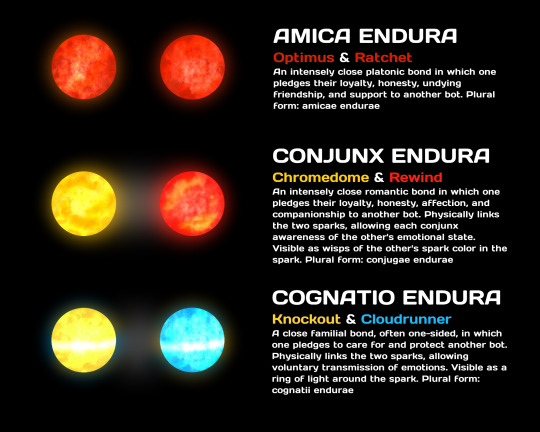
[Image ID: A chart detailing the different spark bonds. The first pair of sparks are slightly differing shades of red, with their glows not touching, and are labeled “Amica endura, Optimus & Ratchet. An intensely close platonic bond in which one pledges their loyalty, honesty, undying friendship, and support to another bot. Plural form: amicae endurae.” The second pair of sparks are yellow and red, each one having some of the other’s color in it, and have their glows touching, mingling in the center. They’re labeled “Conjunx endura, Chromedome & Rewind. An intensely close romantic bond in which one pledges their loyalty, honesty, affection, and companionship to another bot. Physically links the two sparks, allowing each conjunx awareness of the other’s emotional state. Visible as wisps of the other’s spark color in the spark. Plural form: conjugae endurae.” The third pair of sparks are gold and bright blue, each with a ring of light around their centers, and whose glows mingle and begin to bleed into each other. They’re labeled “Cognatio endura, Knockout & Cloudrunner. A close familial bond, often one-sided, in which one pledges to care for and protect another bot. Physically links the two sparks, allowing voluntary transmission of emotions. Visible as a ring of light around the spark. Plural form: cognatii endurae. End ID]
Other bonds
There are, of course, other bonds out there; those that take other forms, such as when a Cybertronian adopts an alien custom, those that have different implications, such as Seeker Trine bonding, and those that are fundamentally unique, such as the connection between split-spark twins. The list can go on forever, but as they are not involved with the vast majority of the Cybertronian race, they will be saved for another post.
In conclusion
Sparks are complex, diverse, fascinating aspects of Cybertronian physiology, and the more we study them, the more our definitions update and adapt.
I hope you’ve enjoyed this read. It was an incredible study to make. If you have any more questions about Cybertronians, feel free to hit up my inbox. Thank you for reading!
☕
#transformers#transformers: prime#with a little bit of#more than meets the eye#mtmte#tfp#cybertronian biology#sparks#the big question: do i rp my oc as i answer this#i am HIGHLY tempted to#also yes i'm aware that knockout is spelled knock out#he will always be knockout to me#this took me well over *checks watch*#11 hours to make#worldbuilding#theory#biology#physiology#my art#i think the most challenging part of this was how to approach cybertronian dimorphism#because it varies wildly between 'ah yes human gender binary' and 'they're robots and agender. what do you want'#had to take both of those in because they're both canon#i like what i came up with though#it pleases my agender heart#long post#sure why not
113 notes
·
View notes